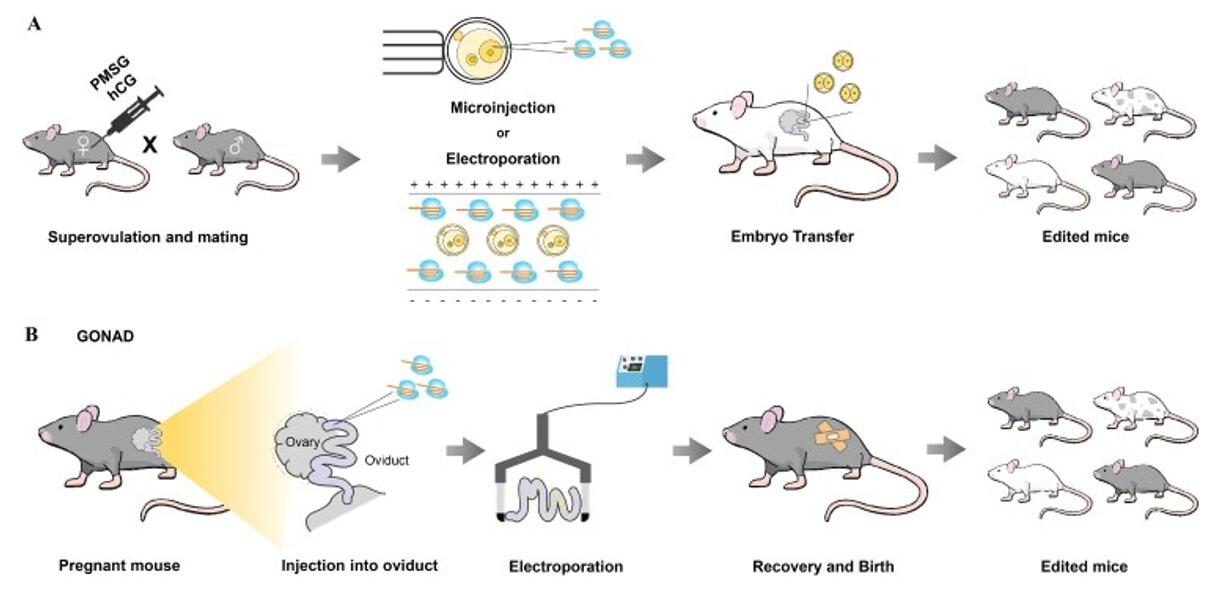
Our promise to you:
Guaranteed product quality, expert customer support.
 24x7 CUSTOMER SERVICE
24x7 CUSTOMER SERVICE
 CONTACT US TO ORDER
CONTACT US TO ORDER
CRISPR Mouse for Disease Modeling 
Genetically engineered animal models that reproduce human diseases are important for the pathological study of various conditions. The development of clustered regularly spaced short palindromic repeats (CRISPR) systems has allowed for faster and less expensive production of animal models than traditional gene targeting methods using embryonic stem cells.
CRISPR makes gene editing of complex animals relatively simple and is commonly used to mimic human diseases because mouse models are highly homologous to the human genome. These models lead to functional insights into human genetics and allow the development of potential new therapies. For example, human GWAS identified a potential pathological SNP (rs1039084 A > G) in the STXBP5 gene, a regulator of human platelet secretion. The mutation was then replicated by CRISPR in mice with a nearly identical thrombogenic phenotype, thus confirming the causal relationship of this SNP in humans.
 Fig. 1 A mouse modeling approach using the CRISPR system. (Lee H, et al., 2020)
Fig. 1 A mouse modeling approach using the CRISPR system. (Lee H, et al., 2020)
Solution
Our methods for producing animal models using fertilized embryos with CRISPR systems include microinjection, electroporation, and genome editing by oviductal nucleic acid delivery (GONAD). We offer the following animal models for generating and treating human diseases based on genome editing approaches:
- CRISPR Mouse for Cancer Modeling
- CRISPR Mouse for Neurodegenerative Disease Modeling
- CRISPR Mouse for Cardiovascular Disease Modeling
- CRISPR Mouse for Metabolic Disease Modeling
- CRISPR Mouse for Immunodeficiency Disease Modeling
Specifically, our models include but are not limited to tyrosinemia, immunodeficiency, lateral meningeal bulge syndrome, osteoporosis, osteogenesis imperfecta, Acampomelic campomelic dysplasia, Campomelic dysplasia, cancer, hemophilia A, hemophilia B, Duchenne muscular dystrophy, amyotrophic lateral sclerosis, tyrosinemia, AIDS, Huntington's disease, age-related macular degeneration, and Alzheimer's disease.
Our Strategies for Creating Gene Editing Mice
Our methods for making animal models using fertilized embryos with CRISPR systems include microinjection, electroporation, and genome editing by GONAD. Microinjection is a method of injecting Cas9/gRNA complexes directly into the cytoplasm or protoplast of fertilized single-cell embryos, while electroporation enables gene editing by inducing electrical stimulation of fertilized single-cell embryos in the presence of Cas9/gRNA complexes. gONAD is a novel method of introducing Cas9/gRNA complexes into embryos without sacrificing animals. The Cas9/gRNA complex for genome editing is injected directly into the oviduct of pregnant mice and then electroporated in situ.
Our Workflow
- Design and synthesis of CRISPR/Cas9 reagents
- Injection into embryos or cell transfer into blastocysts
- Reimplantation into foster female
- Husbandry and weaning
- Sample collection for genetic testing
- Full health report
- Delivery of gene editing mice
Related Services
- Conditional Knockout Mouse
- Conventional Knockout Mouse
- Point Mutation Mouse
- CRISPR/Cas9 Knockin Mouse
- Rosa26 Knockin Mouse
Related Products
CRISPR/Cas9 PlatformCB is the world's leading gene editing biotechnology company, dedicated to providing the most professional and comprehensive gene editing technology solutions to our customers. If you are interested in our services, please feel free to contact us.
References:
- Lee H, Yoon DE, Kim K. Genome editing methods in animal models. Anim Cells Syst (Seoul). 2020, 24(1):8-16.
- Zhu QM, et al. Novel Thrombotic Function of a Human SNP in STXBP5 Revealed by CRISPR/Cas9 Gene Editing in Mice. Arterioscler Thromb Vasc Biol. 2017, 37(2):264-270.